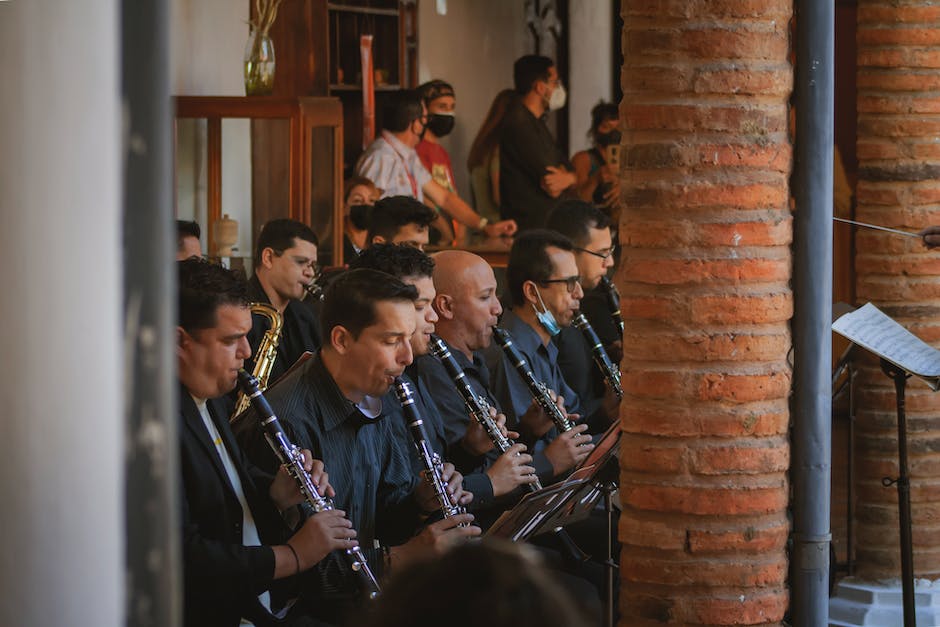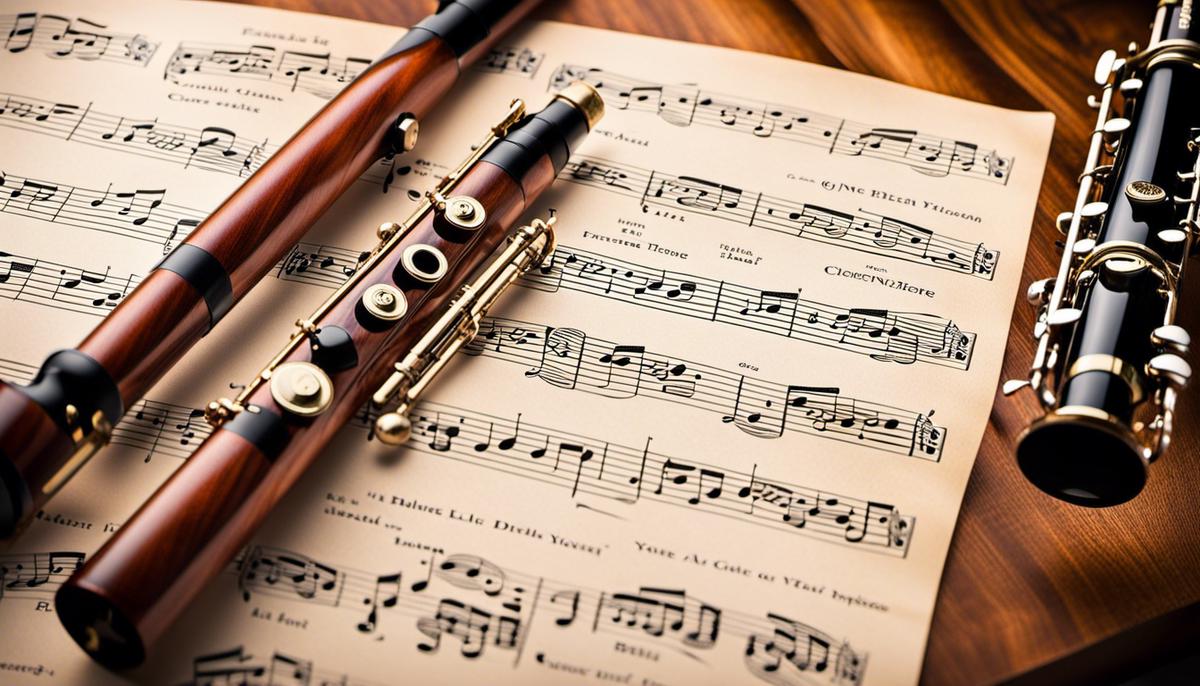Table of Contents
Introduction
The unique chamber music configuration of the clarinet quartet has captured the imagination and creative prowess of numerous composers, reflecting the rich and versatile tonal colors of the instrument.
In this article, we will discuss clarinet quartets, including a few notablt, learn the elemental techniques for quartet playing, engage with notable compositions.
Understanding Clarinet Quartet
Understanding Clarinet Quartet
A Clarinet Quartet is an ensemble of four clarinets that typically consists of a B-flat (Bb) soprano clarinet, an E-flat (Eb) alto clarinet, a Bb bass clarinet, and a Bb contrabass clarinet. The timbral variety between these instruments allows for a rich diversity of sound, mirroring the intricacy found in string quartets. The soprano clarinet typically carries the melody, while the alto and bass clarinets establish the harmonic foundation, and the contrabass clarinet serves to reinforce the bass line.
The history of the clarinet quartet began in the 19th century, following the invention of the clarinet. The formation of the quartet was not common until the 20th century when composers began writing specifically for this ensemble. One such early example is Paul Hindemith’s ‘Clarinet Quartet,’ composed in 1938. Today, the quartet is recognized for its unique contrasting tonal colors and capacity for a wide range of music styles, from classical to jazz.
Roles of the Clarinets in a Quartet
In a clarinet quartet, each instrument has a distinct role. The B-flat soprano clarinet, the highest-pitched of the four, ordinarily carries the melody, bringing brightness and clarity with a potent, piercing tone that can cut through the texture of the ensemble.
The E-flat alto clarinet adds a darker, richer tone color to the quartet, providing harmonic support. This middle voice in the quartet is crucial in linking the melody and bass lines, creating a coherent tonal blend.
The B-flat bass clarinet provides rhythmic and harmonic foundations, mainly playing the bass line, comparable to the cello in a string quartet. This instrument adds depth to the quartet with its low, resonant, and flexible tone, contributing to the overall texture and resonance.
The B-flat contrabass clarinet generally acts as the grounding force of the quartet, providing a robust foundational bass line. Its dark, booming sound lends an extra layer of richness to the quartet, creating impressive resonance, especially when the group performs in large halls or auditoriums.
The Unique Role of the Clarinet Quartet in Music
The clarinet quartet holds a special status in the realm of music due to its distinctive sound and flexibility. Unlike congregations of assorted instruments seen in other chamber music groups, a clarinet quartet allows for the exploration of the vast range of tonality and flexibility that comes with a single instrument family, enticing diverse audiences. It possesses the capability to emulate an eclectic mix of moods and settings, spanning from the profoundly serious to the mildly playful. The adaptability of a clarinet quartet permits it to interpret a wide array of musical styles, forming connections with listeners of different musical tastes.
The value of a clarinet quartet goes beyond aesthetics; it’s also an extraordinarily informative ensemble, promoting skills like effective communication, attentive listening, and keen interaction among musicians. Each player becomes adept at managing their dual roles as a soloist and an integral part of a team, honing vital musical skills that carry over to other arenas of performance and musicianship.
Additionally, emerging as well as seasoned composers have fostered the expansion of clarinet quartet literature, recognizing the significant potential of this arrangement. This has resulted in a multitude of original compositions and adaptions that further accentuate the virtues of this ensemble. Whether it’s renditions of serene Renaissance choral music or cutting-edge compositions with a jazz bent, the catalogue of the clarinet quartet ceaselessly expands, further solidifying its enduring reputation and magnetism in today’s musical landscape.

Fundamental Techniques for Playing in a Quartet
The Anatomy of a Clarinet Quartet
Usually, a clarinet quartet consists of four individual clarinetists, each responsible for a different segment of the musical pitch spectrum. The four conventional constituents include the Bb soprano clarinet, the Eb alto clarinet or an additional Bb clarinet, the Bb bass clarinet, and either the Eb contralto clarinet or Bb contrabass clarinet. The particular choice for the fourth clarinet is generally dictated by the requirements of the music piece in question.
The Importance of Intonation
One of the essential technical skills required in a quartet is intonation, or the accuracy of pitch in playing. Intonation in a quartet is more than just ensuring you’re at the precise pitch; it’s also understanding how your tone blends with the three other players. Avoiding disharmony is critical, particularly during chord progressions, as any inconsistencies in intonation can upset the overall harmony of the quartet. Intonation exercises, such as practicing with a tuner or playing scales in unison, can help improve this skill.
Rhythm and Timing
In a clarinet quartet, keeping rhythm and timing is crucial. It’s not enough for each player to be able to keep pace individually; the real mastery comes in being able to adjust your playing to the quartet’s overall rhythm. This includes responding to slight changes in tempo and synchronizing entry points in the music piece with precision. Using metronomes and tuners as practice tools and performing exercises like rhythm drills can significantly bolster your timing skills.
Balancing Tone and Volume
Tonal balancing involves adjusting your playing such that your sound complements the rest of the quartet. Achieving balanced tonality is about blending voice parts to create a harmonious overall collective sound. This also extends to volume, as each player must regulate their individual volumes to ensure the proper balance in the quartet. Techniques for enhancing tone balance include conscientious listening, recording, and critiquing practice sessions, and consistent practice of long tones and dynamic changes.
The Art of Listening and Blending
The artistry of quartet playing lies in the ability to listen actively and blend your sound with the other players. This skill requires that you listen not only to your playing but also to the rest of the quartet, adjusting each note’s pitch and volume accordingly to ensure a harmonious collaboration. It might assist to think of the quartet as a single instrument that you are all playing together, rather than as four separate individual instruments.
Practical Exercises to Improve Skills
There are many practical exercises you can perform to improve your quartet playing skills. These might involve unison tone and rhythm exercises, movement shifting, and balance exercises. You could start by playing simple scales in unison, then move to more complex scales and arpeggios. Additional exercises might entail taking turns playing as the leading voice, or picking a pattern or beat and moving your playing to match. The key is consistent, mindful practice and mutual feedback amongst quartet members.
Mastering the art of the clarinet quartet demands not only individual technique but also a firm grasp of the ensemble ethos. Achieving harmony within a quartet goes beyond aptitude and calls for a keen focus on orchestration and sound cohesion. Like all abilities, it improves with practice, which will eventually lead to a noteworthy proficiency.

Exploring Notable Clarinet Quartet Compositions
Noteworthy Clarinet Quartet Compositions
The genre of clarinet quartet is recognized for its vast and wealthy repertoire, graced by glorious compositions from world-renowned composers. Works including Mozart’s “Quartet for Clarinet and Strings in A Major” and Brahms’ “Clarinet Quartet in B minor” stand at the pinnacle of quartet music. Their intricate blueprints, deep emotional resonance, and challenging technical elements are what set them apart as sublime quartet compositions.
The Quintessential Mozart
Mozart’s “Quartet for Clarinet and Strings in A Major,” colloquially known as “Clarinet Quartet K. 581,” was written for the renowned clarinetist Anton Stadler. Comprising four movements – an Allegro, Larghetto, Menuetto, and Allegretto con Variazioni – the piece showcases Mozart’s deep understanding of the clarinet’s tonal range. The elegant interplay between the clarinet and the stringed instruments creates an aural tapestry that is as textured as it is melodious.
Analyzing “Clarinet Quartet K. 581,” one encounters a perfect blend of harmonic structure and melodic flow. The clarinet’s melody often echoes the composition’s main theme, maintaining a cohesive musical narrative throughout, even as the piece ventures into complex harmonic territories.
Brahms’ Clarinet Quartet in B Minor
Moving forward in time, Brahms’ “Clarinet Quartet in B minor” is often regarded as a cornerstone of the 19th-century Romantic repertoire. Inspired by the virtuoso clarinetist, Richard Mühlfeld, Brahms incorporated rich, lyrical melodies and intricate rhythmic variations into his quartet compositions.
In the “Clarinet Quartet in B minor,” Brahms complements the clarinet’s inherent vocal-like qualities with a trio of stringed instruments – the violin, viola, and cello. The composition exhibits the Romantic era’s characteristic warmth and depth, with layers of harmonies mirroring the emotional depth and complexity of the era.
Techniques Employed in Clarinet Quartet Compositions
The beauty of clarinet quartet compositions lies in the interweaving of thematic material between the participants. Composers often use the technique of call-and-response, where one instrument introduces a melodic idea that is then “answered” by the others.
The four parts typically consist of two soprano voices (often the two clarinets), an alto voice (usually the viola), and a bass voice (usually the cello). This arrangement, which mimics the human four-part choir, lends itself to complex tonal relationships and harmonic richness.
Role of the Clarinet in Quartet Compositions
In quartet compositions, the clarinet assumes a leading role, driving the harmonic progression and thematic development in the music. Its ability to oscillate between poignant lyricism and vibrant virtuosity lends itself well to the dynamic and emotional demands of quartet music.
Navigate the Prelude and Recapitulation Structures
Quartet pieces generally follow the sonata form, which includes a prelude or exposition, development, and recapitulation. This form, characterized by the introduction, exploration, and then restatement of multiple themes, provides a structured framework within which composers can experiment with harmonic ideas.
Diving deep into well-known quartet pieces and the techniques used in them can help enthusiasts and hobbyists like you fully understand and appreciate the immense creativity and skill encapsulated in the realm of clarinet quartet music.

Rehearsal Techniques and Performance Tips
The Necessity of Consistent Rehearsals
Playing in a clarinet quartet is a complex blend of personal proficiency and group coherence. Consistent rehearsals are an invaluable aspect of any quartet’s journey to growth and successful performances. These rehearsals don’t just facilitate the individual musician’s mastery over their parts but also build a strong bond within the group. Regular practice hones technical skills and prepares the group to adeptly handle the subtleties of dynamics, articulation, and rhythm, all crucial aspects of quartet music.
Effective Rehearsal Techniques
Rehearsing as a quartet for a clarinet performance requires more than playing through a piece repeatedly. An effective rehearsal should begin with warm-ups before moving on to section rehearsals, where each part is meticulously worked on. Here, the musicians should focus on mastering the technical aspects of their parts, such as rhythm, pitch, and articulation. Following this, the quartet should assemble to rehearse the complete piece, allowing them to integrate their parts into the whole. During this stage, the emphasis should be on cohesion, balance, and ensemble. Breaking down the music into manageable sections and running through them slowly before working up to the performance tempo can also be beneficial.
Group Dynamics Management
Learning to manage group dynamics effectively is another critical aspect of rehearsing as a quartet. As a group, make sure communication is always open and respectful. Working as a team means understanding and respecting individual strengths and weaknesses, and working together to create a cohesive performance. Regular tete-a-tetes on the interpretation of the piece, individual inputs, and suggestion sessions can go a long way in managing group dynamics.
Performance Strategies
In addition to meticulous rehearsal, specific performance strategies can ensure a successful concert. Familiarize yourself with the performance venue beforehand, so you understand the acoustic conditions and can adjust your playing accordingly. Thoughtful programming also plays a role in a successful concert. Choosing a varied repertoire, that not only showcases the quartet’s technical abilities but also appeals to the audience’s musical preferences, can make a significant difference.
Nervousness Management
It’s also essential to know how to manage stage nerves. Perform regularly in front of others, whether in rehearsals or informal performance opportunities, to become comfortable playing in public. Some deep-breathing and relaxation techniques can be helpful in managing performance anxiety on the day of the actual concert.
The Power of Visual Communication
Lastl0ly, a great performance in clarinet quartet music doesn’t just rely on what the audience hears. Visual communication also has a substantial impact on the interpretation of the music. Ensure that quartet members are visually engaged in the performance and convey the emotion of the piece to the audience.
By applying these principles and strategies, you can prepare for and deliver an exceptional performance as a clarinet quartet.
Conclusion
Success in a clarinet quartet performance requires more than knowledge and technical prowess; it calls for a shared vision, collaborative effort, and an intimate understanding of the musical language and the nuances of communication it entails. The exploration of famous quartet compositions, interpreting the key elements, and learning the techniques employed, bring a greater depth to your understanding. Coupled with the right rehearsal techniques, discipline, respect for group dynamics, and performance strategies, you’ll unlock the potential to offer an engaging, immersive, and emotionally resonant musical experience. Appreciating and performing clarinet quartet music not only enriches your musicianship, but also offers a profound insight into the endless possibilities of shared musical narratives.
Additional Reading
Take some time to check out our other articles:
Breve Music Studios publishes music to Spotify, YouTube Music, Amazon Music and more. Follow our pages on Facebook, Instagram, Twitter, TikTok, and YouTube.
Listen to our ensembles: Breve Orchestra, Breve Music Ensemble, Breve Low Brass Ensemble, Breve Woodwind Ensemble, and Jermaine Harris on Spotify.

